Looking for a way to boost productivity and raise employee and customer satisfaction at the same time? The right team communications app could be the answer.
A good workplace communication app could revolutionize the way your teams work. By making communication clearer, faster, easier, and more accessible, you can unlock potential in your staff that you didn’t even realize existed.
But first, you have to find the right tool.
To help you out, we’ve looked through the top team communications apps and come up with a list of 11 that might provide what you need.
- What is a team communication app?
- Best team communication app overview
- What to look for in a team communication app: How we assessed the top tools
- 11 Business communication app alternatives to choose from
- How does a team communication app work best? Hints and tips
- Benefits of using a team communication app
- Team communication app FAQs
What is a team communication app?
A team communications app helps your business work more efficiently. Unlike more general messaging apps, they’re designed to increase productivity through enhanced collaboration.
Work communication apps should have features designed with the modern workplace in mind. For example, making it easier to categorize and distribute messages by subject so that people don’t have to scroll through chats that are irrelevant to their own work.
Best team communication app overview
There are lots of top team communication apps out there to choose from. We’re going to go in-depth on 11 possible options right here in this guide.
If you’re short on time, though, here’s a shorter overview of the best apps for team communication:
| Team Communication App | Key Features | Pricing Details |
| RingEX | Massive variety of integrations. Plenty of task and team management tools. Quick instant messaging, file-sharing, and annotation features. Quick and easy voice and video calling. | Free trial. Plans start from $20/user/month |
| Slack | Chat streamlining, strong organizational features, intuitive design. | A freemium tier and paid plans from $8.75/user/month |
| Microsoft Teams | Great integration with other Microsoft products, good audiovisual quality. | Paid business plans are billed annually from $4/user/month |
| Google Chat | Excellent integration with other Google products. Enhanced search capability. | Included with Google Workspace. Paid Workspace business plans from $7.20/user/month |
| Trello | Excellent project and task management tools with inbuilt messaging functionality | Freemium tier for basic features. Plans start at $5/user/month if billed annually, and $6/user/month if billed monthly. |
| Wire | Great security. Features like “self-destructing rooms” are useful for secure meetings with people outside the business.. | Pricing starts at $5.83/user/month |
| Chanty | Good task management and file sharing tools. | Plans from $3/user/month |
| Pumble | Unlimited message history, secure guest access, comprehensive suite of messaging features. | Pumble has a very basic free tier. The cheapest paid tier is $2.49 if billed annually and $2.99 if billed monthly. |
| Flock | Good project management and collaboration tools | Enterprise prices vary. Pro costs $4.50/user/month |
| Spike | Streamlined tool integration, 1-click video meetings. | Basic free tier. More comprehensive plans from $4/user/month |
| Discord | Always-on audio, competitive pricing. | Freemium tier for basic features, extra features come with the $9.99/month Nitro plan |
What to look for in a team communication app: How we assessed the top tools
So you know what we’re basing our list on, here’s the criteria we used to choose our top 11 team communication apps:
- Ease of use
- Channel structure
- Reporting features
- Integrations
- Customer support
- Extra features
- Security
- Pricing
We also worked on the assumption that ideally our chosen apps would allow for video calls as well as instant messaging. Where that isn’t the case, we’ve mentioned it.
11 Business communication app alternatives to choose from
1. RingEX from RingCentral
We might be a bit biased here, but we believe that RingEX truly deserves to be at the top of this list. It’s an intuitive team communications tool with an impressively broad feature-set and so is one of the best of all available company communication apps. 
As well as text-based chatting, you can do everything from quick voice calls to check in to full-blown video conferences with ease. Let’s take a closer look at the key features of RingEX:
Key features
RingEX has well-organized, streamlined chat channels, plus integrated voice and video calling, simple yet secure file-sharing, and numerous task management tools.
One of the other key strengths of RingEX is its integrations with other popular business apps. You don’t have to platform-hop when doing things like sharing files. Users can share and annotate documents without leaving the RingEX platform.
Similarly, RingEX can be embedded into your favorite tools and platforms, so you can do things like update your CRM via the RingEX integration.
Notable pros and cons
RingEX is a versatile one-stop solution for everything you need in a team communications platform. It facilitates clear communication and productivity across your organization.
All of this stuff doesn’t come for free, of course, but RingEX is cost-effective for the features and performance it provides.
Pricing
Pricing starts at $20 per user, per month. Best value is arguably the Ultra tier, which offers a complete suite of features for $35/user/month (paid annually).
2. Slack
Slack is a popular team communication app that allows for well-organized, productive conversations through streamlined chat channels. The app is easy to use and has a fair range of integrations. If you’re looking for an intuitive, app-based alternative to email, Slack is a decent option.

Image sourced from G2
Key features
Slack has slick, well-organized messaging channels that allow for team discussions and one-on-ones. It’s well-optimized for mobile, making it handy for remote team communication, and its search tool makes it easy to pull up information and files very quickly.
Notable pros and cons
Slack is very well known, which means that it has a lot of potential integrations, and many users will already be familiar with how it works (meaning you won’t have to train them as much).
The major downside of Slack is that it’s primarily a text-based app. It’s great for messaging and file-sharing, but “voice-first huddles” and video clips aren’t as efficient as the full-fledged video conferencing built into some other solutions.
Pricing
Slack has a basic freemium plan. Paid plans are designed to fit in with businesses at different stages of development. The cheapest is the Pro plan, at $8.75 per user, per month.1
3. Microsoft Teams
Microsoft Teams is another big-hitter on this list. It’s widely used for video conferencing, especially by businesses that use a lot of contractors and remote workers. Its widespread nature makes it easy for anyone to hop on a Teams call, which makes it useful for companies that make a lot of calls outside their own business.

Image sourced from Capterra
Key features
Microsoft Teams offers a wide variety of features, including video calling, real-time file sharing, chat functions, and integrated file-editing. It also integrates with a lot of popular workplace platforms like Trello and Adobe Creative Cloud. You can also integrate RingCentral’s telephone, SMS, and fax into Microsoft Teams to make it a one-stop communication hub.
Notable pros and cons
The basic, “Home Plan” version of Teams is free to use and can be accessed relatively easily from anywhere with a basic feature set. The cheapest business Plan is Microsoft Teams Essentials. It has a variety of chat features and functions, including real-time file sharing and in-platform file editing.
On the downside, its advanced features can be complicated and require a bit of training.
Pricing
The basic version of Teams is free with a Microsoft 365 subscription. If your business uses Microsoft 365 a lot then this is a great deal. If you don’t, paying for the full Microsoft suite when you only need a chat app would be a bad budgetary decision.
Away from the M365 subscription, paid plans for Microsoft Teams start at $4 per user, per month.2
4. Google Chat
Google Chat comes as part of Google Workspace. You are likely familiar with or already have some Google Workspace tools. The suite includes Gmail, Google Calendar, Google Docs, Google Drive, and more.
Google Chat is Google’s attempt to bring team chat functionality into their Workspace suite. In theory, Google Chat allows teams to message each other while working with Google products. It allows for team calls and catch-ups, and integrates relatively well with Google Meet for video conferencing.

Image sourced from Trustradius
Key features
Google Chat offers spaces for team updates, project discussions, one-on-one hangouts, and more. It has all the chat features you’d expect from a giant like Google, and integrates with the other tools in Google Workspace. When combined with other Google products, it can provide a decent array of tools and capabilities.
Notable pros and cons
Google has huge brand recognition. Everyone is familiar with it and how its products work. This means that Google Chat has a relatively low learning curve. It also offers a decent range of work-related chat functions.
However, despite being made by the same company for the same suite, it’s not always simple to integrate Google Chat with other Workspace tools like Docs or Drive. Some platform-hopping is necessary to get the best out of Google Chat.
It’s also worth noting that the layout of Google Chat can be confusing. It’s all too easy to message the wrong person, which isn’t great if you work with sensitive information.
Pricing
Individuals can use Google Chat for free. Paid Workspace business plans start at $7.20 per user, per month.3
5. Flock
Flock is a team collaboration app combining chat channels with project management tools. Its USP is streamlining chats and workflows for enhanced productivity. It aims to help teams slash the time they spend trying to parse chat streams and dig information out of old messages, and to keep conversations productive.
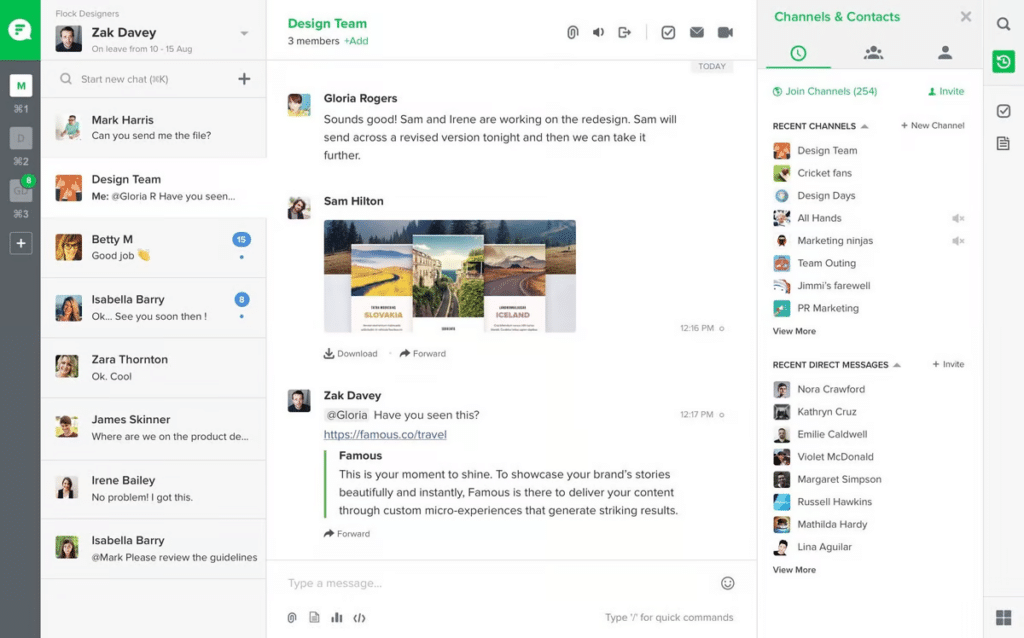
Image sourced from G2
Key features
Flock has a lot of features which help teams to get clarity on projects and tasks at a glance. For example, it’s easy to assign tasks to team members, apply deadlines, and pin important chat items. You can also create team polls to quickly take the team’s temperature on issues, or to make informed decisions.
Flock also has an automatic opening feature, which makes sure that nobody misses any important messages.
Notable pros and cons
Flock has a reputation for reliability. It delivers on its claims to enhance communication and collaboration, in part due to its automatic opening feature that makes sure that messages always get in front of the right eyes. It is also great for keeping communication organized.
That being said, larger teams have experienced issues when using Flock, noting that the organizational features start to lose effectiveness as chat channels get larger. And, as a blow for freemium users, the free tier does not include group video calls.
Pricing
Flock encourages businesses considering its Enterprise tier to contact them for a quote. For the Pro tier, prices start at $4.50 per user per month.4
6. Trello
Trello is a well-used project management tool. Its Kanban board system is very popular, and is a format that’s hard to beat in task management terms. It also allows users to comment on aspects of tasks and projects, share files, and message one another.
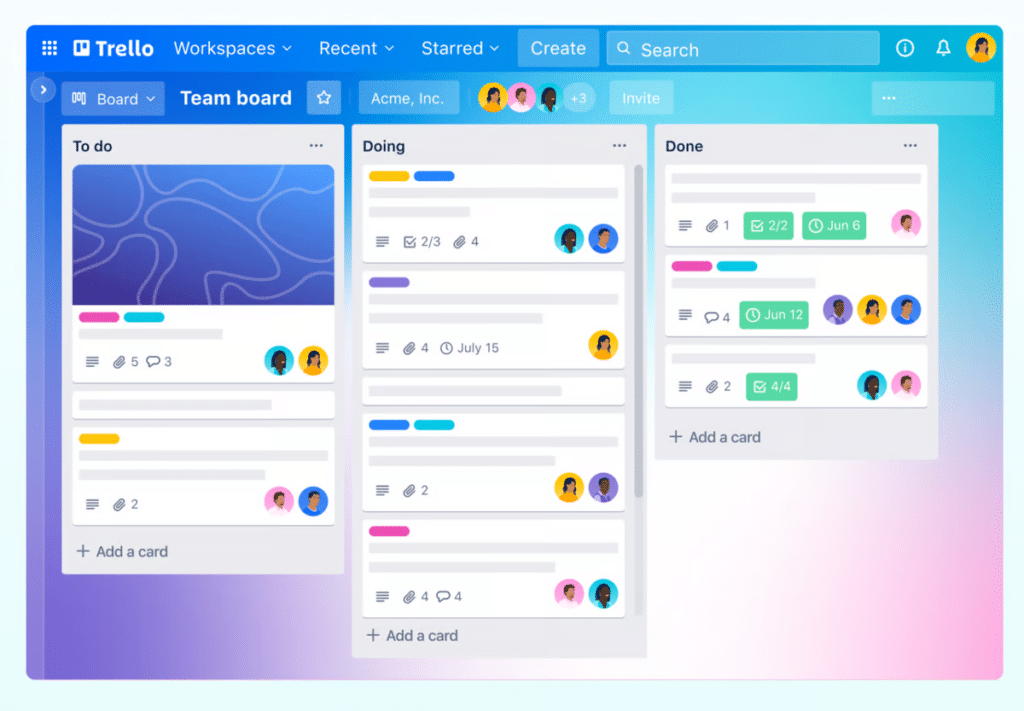
Image sourced from G2
Key features
Trello is not, strictly speaking, a chat app. It made this list because its task management features are great for team collaboration. Trello’s boards make it easy to see what’s ongoing, who’s responsible for what task, when tasks are due, and so on. Users can also flag issues, leave comments, and share files on Trello’s Kanban boards.
Trello does also offer chat features in case people want to raise issues with other users privately. It’s also worth noting that Trello integrates well with team communication apps like RingEX, so you can get the best of project management and team collaboration.
Notable pros and cons
Trello is fantastic for task and project management, and it integrates beautifully with more comprehensive team communication tools like RingEX.
However, it isn’t a dedicated chat app. While it offers some chat functions, it’s less suitable as a standalone communications tool.
Pricing
Trello has a freemium tier offering all its basic features. To unlock features like unlimited boards and greater admin capabilities, users will have to pick a paid plan. Plans start from $5 per user, per month when billed annually and $6 per user, per month when billed monthly.5
7. Wire
Wire describes itself as a “collaboration platform”, and offers all the chat, file-sharing, and conferencing options you’d expect from a mid-range example of the genre. What sets Wire apart from some others is its security.
Wire is designed with security in mind. It offers full end-to-end encryption for all chats, and “self-destructing rooms” which delete once the conversation has finished.
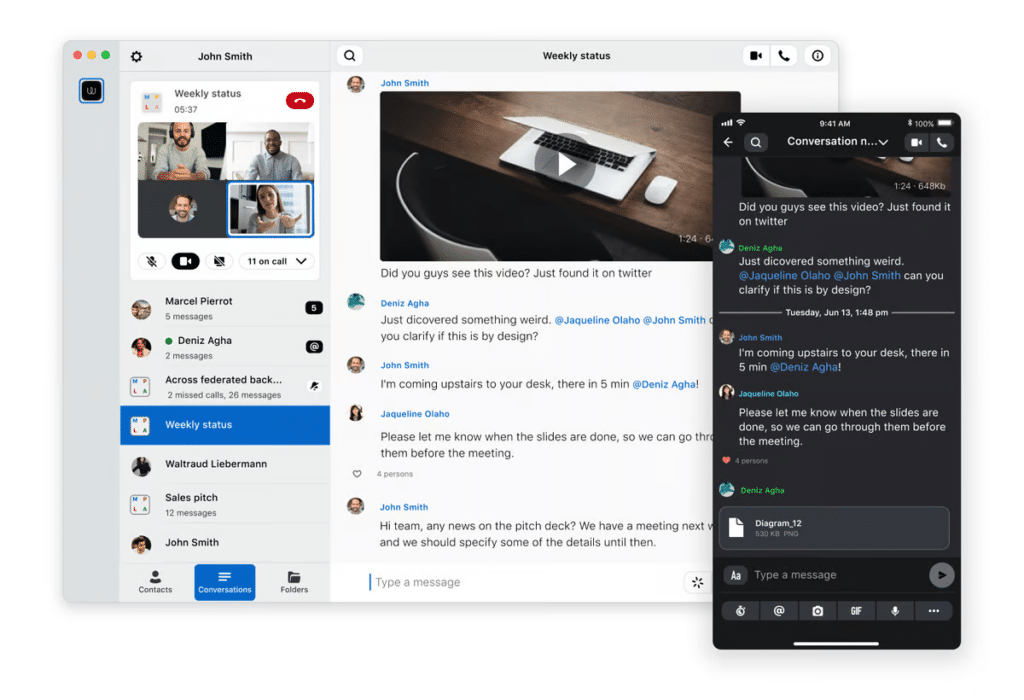
Image sourced from G2
Key features
Wire offers instant messaging, team messaging, video calling and conferencing, file sharing, and some team management tools. Where it differs from other apps is in its open-source nature and its security features.
Because it is open-source, it can be customized to the needs of each business. And its security features are second to none. Self-destructing chats are an especially nice feature if you need James Bond-style security measures for your business conversations.
Notable pros and cons
As we’ve covered, the level of security and inventive security features Wire offers are fantastic. That being said, if security isn’t such a priority for you, you won’t find much exceptional about Wire. Its regular chat features are as you’d find with most other tools.
Pricing
Wire pricing is not widely advertised. You need to contact the company for a quote.6
8. Chanty
Chanty is like a simpler, cheaper version of Slack. If you’re looking for something that sends messages, makes calls, and helps out with project management, Chanty could be the choice for you. It doesn’t offer much in the way of extra features, but the features it does have work well.
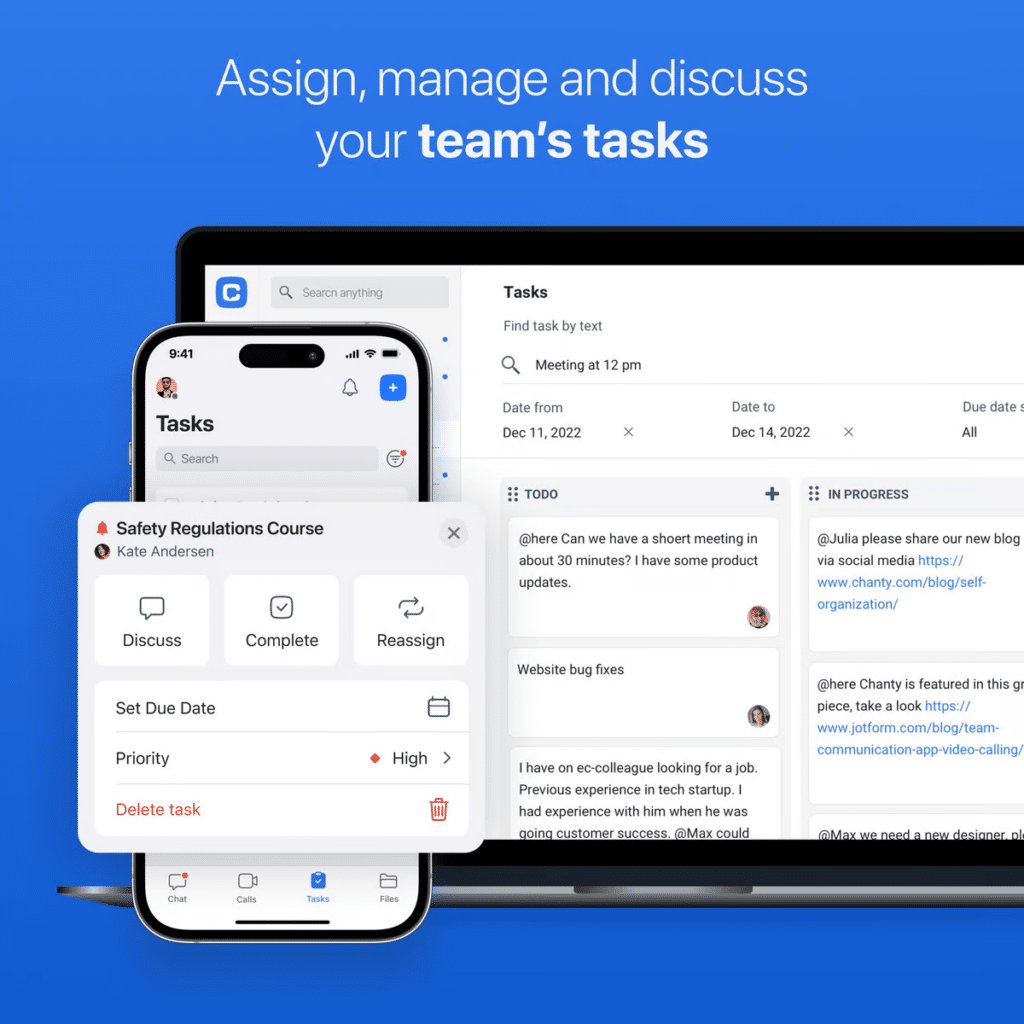
Image sourced from G2
Key features
Chanty allows for standard chat, voice calling, and video calling. In addition, it has a project management Kanban board which is great for facilitating workflow automation. Its file sharing capabilities are also noteworthy.
Notable pros and cons
Users love Chanty’s Kanban board and file sharing features. Chanty is also very good at enabling low-level communication between large remote teams.
However, for businesses that need higher-level communication, Chanty may not be ideal. It’s not really designed for wide and complex communication networks, and will struggle to provide for larger businesses with diverse communication needs.
Pricing
There is a limited free Chanty plan, and then a slightly more comprehensive business plan at $3 per user, per month (paid annually).7
9. Pumble
Pumble is a comprehensive team communications app offering unlimited message history alongside all the usual communications features. It’s versatile and robust, and can easily handle the demands of larger or more complex teams.
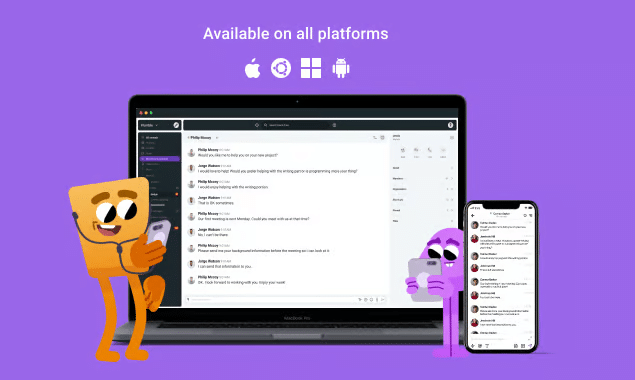
Image sourced from G2
Key features
Pumble is known for its unlimited message and file storage. This means that users don’t have to worry about any important information getting lost, and don’t have to transfer data to another platform or format if they don’t have the time or capacity to do so. Users can easily search through messaging history to quickly come up with chat threads from years back if needed.
Pros and cons
Pumble’s centralized storage system makes it very easy to both store and find data. It has an impressive array of security features, and permissions can be adjusted on a granular level to make sure that only the right people can see sensitive conversations or access sensitive files.
However, Pumble is designed for large, tech-savvy teams with complex communication needs. More casual users may find its interface intimidating, and struggle to phrase search queries in the precise way that Pumble demands.
Pricing
Pumble does have a free tier, but it’s pretty basic. Paid tiers start at $2.49 per user, per month if billed annually and $2.99 per user, per month if billed annually. For best value for money, the Cake bundle is advised—$12.99 per user, per month annually or $15.99 per user, per month monthly.8
10. Spike
Spike uses AI to organize emails and, if needed, transform email chains into more accessible chats. It helps users to deal with messages in order of urgency, and makes sure that no important email is neglected.
By turning email chains into chat it adds a real-time element that’s lacking in traditional inboxes. Spike chat chains are also arguably a lot more streamlined and cohesive than rambling email threads.

Image sourced from G2
While Spike is theoretically an email management tool rather than a team communications app, we felt it deserved a spot on this list due to its ability to streamline and enhance a traditional communications channel.
Notable pros and cons
Spike is known for great customer service. It is also widely praised for the way it organizes and consolidates emails into streamlined, intuitive streams. Spike customers say that they find their inboxes much easier to manage, and are able to hold more productive conversations with both clients and teammates using Spike than they are with traditional email alone.
That being said, Spike is not a complete team communications tool. While it is useful at what it does, it doesn’t offer things like video conferencing and voice messaging. It may work better integrated with the email element of your communications platform rather than as a communications solution in and of itself.
Pricing
There’s a free Starter Plan, and then paid business plans starting at $4 per user, per month.9
11. Discord
Discord may be best known as a place where gamers and livestreamers gather to chat, but it also has some capabilities for work teams. Features like always-on voice chat and invite-only channels make it appealing for businesses that want team chats but don’t necessarily need a major communications suite.

Image sourced from Capterra
Key features
Because it’s designed for livestreamers, Discord can effortlessly give clear, high-quality video and vocals. It also allows for a range of user permissions, and the predominant chat feature is easy and intuitive to use.
Notable pros and cons
Discord is great for video messaging, and the chat feature works very well. It’s easy to use, and it’s free. Plus, it allows for plenty of gifs and video embeds. Teams with a more casual, informal culture will get along well with Discord.
However, it’s not designed for workplace chat. While it’s great for basic communication, if you want more complex or secure collaborations you’re better off with another app on this list.
Pricing
You can get the majority of Discord’s features for free. But, if you want faster speeds or a greater upload limit, There’s Discord Nitro. Nitro pricing starts at $9.99 per user, per month.10
How does a team communication app work best? Hints and tips
To get the very best out of your chosen team communication app, you need to come up with good usage strategies. Here are some hints and tips for making your choice work for you:
Train staff in tools and features
Team messaging is a lot smoother and more productive when everyone knows what they’re doing. So, implement training in how the app is used, including all relevant features.
Make sure that you update this training whenever a new integration, tool, or feature is introduced. It’s important that mistakes and misunderstandings don’t occur through simple misuse of the tools.
Establish usage guidelines
Make sure that everyone knows what your app is for and how it should be used. Build up usage guidelines, thinking about things like:
- What should be discussed using this app.
- What should not be discussed using this app.
- What constitutes appropriate language (for example, a zero-tolerance attitude towards hate speech on company channels is a common guideline for ethical businesses).
- Appropriate times for messaging (for example, will you allow messaging outside of work hours?)
- Policies to prevent bullying or harassment over your team channels.
Foster a multi-directional communications culture
Good communication doesn’t just go one way. For a smooth and productive communications culture, make sure things don’t just flow from the top down.
Rather than just delivering orders from management, make sure that people “lower down” the chain feel comfortable using your communication app to ask questions, raise issues, and deliver feedback.
Benefits of using a team communication app
So, when you’ve chosen your perfect team communications app, trained users in how it works, and set usage guidelines in place, what benefits can you expect to see?
Plenty. Effective workplace communication is one of the most important elements of a successful business, and the right app can work wonders for your team communication.
Organization-wide coordination and collaboration
A good AI-powered unified communication solution will bring your organization together like nothing else. By empowering everyone, in every part of your business, to communicate effectively with anyone and everyone else, you will make your organization much more cohesive.
Ultimately, a good team communication solution will massively improve your ability to collaborate across your organization.
Greater productivity
When you don’t have to waste time channel-hopping, platform-hopping, and hunting through confusing email chains for the information you need, you can get a lot more done.
By streamlining and enhancing communications, a good team communications app can give a major boost to productivity.
Easier to support remote working
Many businesses either employ or contract remote workers. A good team communications app makes it easy to integrate remote workers into existing teams and projects no matter where they are in the world.
Improved employee engagement
It’s hard to build engagement when your employees find it hard to communicate. By facilitating smooth, seamless communication across all kinds of channels and formats, your app can play a big part in building engagement.
It will help, of course, if you encourage engagement on the app and cultivate a strong, engaged employee culture. The right app will help you to do this.
Better customer experience
Team communication apps don’t just help your employees. They’re also fantastic for your customers. If you have customer-facing communication channels on your app, you can bring all the benefits of your team communications app to your customers as well.
Even if you’re not using your app to communicate with customers, your customers will reap the rewards of your improved employee engagement, better team culture, and greater productivity.
The right team communication app will benefit staff and customers alike
A good team communications app can work wonders for everything from productivity to customer experience. Something as simple as helping team members to talk to one another can have positive effects that snowball throughout your entire business and customer base.
It’s important that you find a good, unified, versatile team communications app. Remember, you tend to get what you pay for in these matters. RingEX stands out amongst other team communication apps for the sheer amount of features it offers, its reliability, its versatility, and the quality of its customer support.
To learn more about RingEX, get in touch today.
Team communication app FAQs
What is a team communication app?
A team communication app helps your team to collaborate more effectively, which is crucial when it comes to cohesively facilitating a combination of office and remote/hybrid workers. Team communication apps can usually do a number of things, but ultimately they should seamlessly draw together multiple types of customizable internal communication modes into one platform for all users. This is so all your staff (wherever they are) can access your emails, chats, calls, Dropbox files, social media posts and other important information in one place, and work in sync on to-do lists and projects.
Why use apps for communication?
Apps enhance employee communication cohesion, make collaboration and group messaging easy, and help teams get more done with instant access to direct messages, files, and other key project information. Team communication apps help team members interact, communicate, and ultimately get the job done. This is irrespective of geographical disparity, whether yours is a small business or a much bigger outfit, or time differences.
What is the best app for team communication?
RingCentral RingEX is a versatile, comprehensive team communication app. It provides features for businesses of all sizes, from video conferencing to one-on-one instant messaging. Its impressive range of integrations means that it will fit smoothly into any tech stack, and it is priced very competitively.
How can I choose the right app for my business?
When choosing a team communications app, think carefully about what your business needs. A business with a lot of remote workers will need an app that offers a lot of flexibility and versatility. Security will be a priority for businesses that deal with a lot of sensitive information.
Some factors to consider when choosing a team communications app for your business include: the features available, how much customer support is on offer, cost-efficiency, security, and how easy the app is to use.
How much do team communication apps cost?
Team communications apps vary hugely in price. It’s usually worth paying a bit extra for a high-quality app with plenty of integrations and features. But if your budget is tight, many apps offer a freemium tier.
What are the types of team communication apps?
There are few different types of team communication apps. Though all group communication apps aim to do what they say on the tin, the specific type of app you’ll need entirely depends on your needs. Let’s run through some examples.
- Instant messaging and chat apps: These apps allow team members to communicate via text messages, voice calls, and video calls.
- Video conference apps: These apps enable virtual face-to-face meetings and video chats between team members, partners, and clients.
- Project management apps: These apps help team members collaborate on projects, track work, delegate tasks, and share updates.
- File sharing and collaboration apps: These apps mean team members can more easily share, edit, and collaborate on documents and spreadsheets.
- Hybrid apps: These apps blend features to provide a more eclectic and varied option.
What features should be included in team communication apps?
You should expect to find a range of features in team communication apps. Of course, most communication apps are slightly different, and may differ on mobile devices compared to a desktop computer. That said, a team communication app could include HD video, live chat, live messaging, huddle and team meetings, file sharing, screen sharing, conversation transcription, and integration of external apps (such as social media options) as recurring features.
What is the best team communication app?
We really do believe that RingEX features the best combination of attributes to be rightfully considered the best of all the team chat apps on the market. It has the best mix of everything an app should have. From integrated voice and video calling and simple, secure file-sharing, to easy to use, streamlined chat features and a suite of task management options, it covers all the bases, for big or small teams.
RingEX is a versatile one-stop solution for everything you need in a team communication software platform. It facilitates clear communication and productivity across your organization.
Are team communication apps just for enterprises and large organizations?
Businesses of any size can use team communication apps. Good communication is essential for any business to succeed, no matter how big or how small.
RingEX offers a number of payment tiers which allow businesses to pick the deal that works best for them, and scale as and when they need to.
Shopping for a team messaging tool? (Or just curious about what to look for?) Grab the free checklist to help you choose the right one for your team or business.
1 https://app.slack.com/plans/
2 https://www.microsoft.com/en-us/microsoft-teams/compare-microsoft-teams-business-options
3 https://workspace.google.com/pricing.html
4 https://www.flock.com/pricing
5 https://trello.com/en/pricing
6 https://wire.com/en/product
7 https://www.chanty.com/pricing/
8 https://pumble.com/pricing
9 https://www.spikenow.com/pricing/
10 https://discord.com/blog/beginners-guide-to-nitro
Updated Mar 13, 2025










